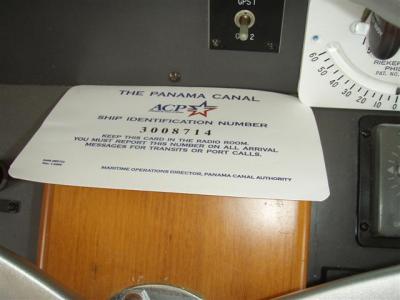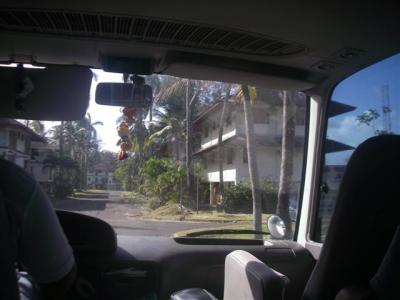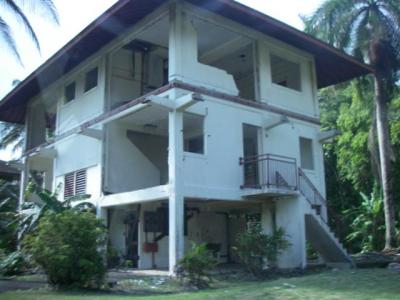This morning Victor knocked on our door at 0730 to let us know the measurer was in the marina. Our boat was third in line, so he would definitely be to Kosmos before noon. Victor told us to be ready to go to town with him at 1300. Eric’s toe was throbbing. We suppose yesterday’s long walk wasn’t such a good idea with a broken toe.
The measurer arrived at 0945. His name is Carlos and he is a nice guy. He measured the exterior, both length and width, and also measured the pilot house dimensions. He had a pile of paperwork to fill out. He asked incredibly detailed questions about how the boat is equipped, looking for minute details, such as “what is the horsepower on the bow thruster?” and “does your propeller turn left or right?” They are serious about knowing exactly how maneuverable the boats are. We can’t remember if we ever mentioned this or not, but early on in the trip our horn broke. Instead of fixing it, we got an air horn. It turns out that you cannot go through the canal without a working horn, but fortunately for us, the air horn was acceptable. Phew!
He explained to us how the canal works. The canal is basically set up for big ships to go through an automated system. They attach steel cables from the ships to locomotives on shore that pull the ships forward from lock to lock. Small boats are a pain for the canal workers. The steel cable rigging system they use is too rough for little boats, so little boats have to be manually handled. At each lock, there are four line handlers on the shore that throw down lines to us from the top of the lock wall, and we attach them to the boat. The line handlers walk alongside us as we motor forward from lock to lock. As the lock fills with water and we rise up to the next level, we bring in the slack on the line. Once at the top, we motor forward to the next lock and repeat the process.
We can choose four ways to transit. One is to be rafted up to a tug. Another is to be rafted up with two other small boats, probably sailboats. The third is to go as a single in the center of the canal. And last is to be tied to the concrete wall. We said our first choice was to go as a single center, but we said we were OK with being rafted to a tug boat, if needed. We said preferred to not be rafted with sailboats, and refused to be tied to the wall.
Carlos also warned us about certain dangers. For example, we need to protect our solar cells because the line handlers above could accidentally hit it with a hook when throwing down the lines. There are no fenders on the lock walls, so it is our responsibility to make sure that we have enough fenders out to prevent damage should we crash into the wall.
Since Carlos was a little on the chatty side, we got some good information from him on related topics, particularly the changes in the administration of the canal since the Americans left. Carlos said that when the Americans first left, many Panamanians working on the canal lost their jobs. He said that Panama was more focused on generating income than America was, and reduced staff to make the canal more profitable. He personally had to take a demotion because they reduced the number of measurers. He has since been re-promoted. The canal currently employs 9500 people directly, and if you include contractors, employs a total of 20,000 people.
He made a comment about how the American military loves to waste money and how Panama misses being the recipient of all that money being thrown away. Sigh. It is good to know our tax dollars our being spent wisely. Carlos also proudly pointed out that the Panamanians have done an incredibly good job of improving the overall efficiency and safety record of the canal since taking over. Currently, the maximum number of ships that can transit the canal in a 24 hour period is 44.
He went on to tell us about the canal expansion project. It is expected to be done in 2014. The canal currently has two sets of locks that are side by side, and a third set of locks is under construction that can hold ships double the size of what the current locks can hold. The waterways in the lake are being deepened and widened to accommodate the larger vessels, as well.
The measuring itself took about 2 minutes, but with all the paperwork and explanation involved, the whole process took a solid 45 minutes. He issued us a formal Panama Canal ship identification number certificate, which is a cool memento.

When Carlos left, we ate breakfast and got ready to go to Colon. Every single source we have consulted has said that Colon is incredibly dangerous for tourists, so dangerous that they pretty much guarantee you will be robbed if you walk around the town. All sources say never to walk anywhere in Colon, even a single block in the middle of the day, and that you must always take a taxi door to door. Lonely Planet says to pick a hotel with 24 hour security and eat all your meals in the hotel because it is too dangerous for a tourist to go to a restaurant. So, needless to say, we were a little nervous about our trip to Colon.
To make matters worse, the $600 transit fee has to be paid in cash, which means we were walking around with an uncomfortable amount of cash on us. We had a couple credit cards on us, as well, because there is also a deposit required for the transit, which is to be paid by credit card. We have had credit card purchases rejected many a time throughout the world because our bank thought the transaction was suspicious and wouldn’t allow it, so we have learned to always have a couple cards on hand, just in case. And, of course, we needed to present our passports as part of the transit paperwork. We split the booty up and put them in secret little places all over our bodies, such as money belts and under shirt pouches. We dressed carefully in baggy clothes that would hide our treasure, but clothes casual enough to not draw a lot of attention.
As we headed out to the bus, we noticed that the marina had filled up. There were a lot more boats here now than there were last night. And, oddly, the new boats were really dirty.
The marina provides a twice daily shuttle bus service that takes you to the closest grocery store on the outskirts of Colon, at 0800 and 1300. We mentioned that the marina is about 10 miles west of Colon, inside a nature preserve. There is no public transportation out to the marina. In order to get to town, vehicles have to cross over the canal at the Gatun Locks. The wait at the locks can be as long as an hour each direction, so taxis refuse to go to the marina. So, the shuttle or a hired private car are about the only way in and out of the marina.
The shuttle is really nice mini-bus and it was already nearly full when we boarded. We eavesdropped as the cruisers around us talked about the shocking news of the day. Apparently, in the wee hours of the morning, a wrecking crew came in and started tearing down the historic Panama Canal Yacht Club, which was opened in 1928 and located in the heart of Colon. From what we gather, it sounds like the owners of the property have been trying to evict the yacht club for years to enlarge adjoining the container port facility, and the yacht club has been fighting it in court. The yacht club claims that the demolition was illegal because the case was still in the court system, but the owners of the land say that it is legal and the yacht club has known for many years this day would come. Apparently, the yacht club’s docks weren’t slated to be torn down as of yet, but it sounds like the cruisers had decided to move to Shelter Bay Marina because their boats were getting dirty from the demolition. Wow. We are glad we decided not to stay there. We can’t imagine being in the middle of that drama.
The bus took a different road out than the one we walked yesterday. This road followed the shoreline. We went by the red roofed office buildings (1st photo below), and maybe a quarter mile down the road passed a series of three story concrete buildings that were clearly once the living quarters for the soldiers. The barracks have been fully gutted, and are now literally no more than concrete walls, floors and a roof. Not even window glass is left in them. The second picture helps give the sense there are a lot of these buildings in here, and the third shows how bad they really are.



At the edge of the former base there was a gate with an armed guard that let us out. Ah, no wonder it is considered “safe” here. We are being protected. Beyond the gate, it was still jungle on both sides of the road. After we had continued on down the road for a few minutes, we saw a huge cruise ship poking out between the trees up ahead. Even though we knew the canal was close, and we knew the ship was really in the canal, it is still hard to express how incongruous it is to see what appears to be an enormous cruise ship sitting in the middle of a jungle. It was actually a funny image and we are bummed we were too slow to catch it with the camera.
To be continued”¦

Made a passage from Cyprus to Port Said recently on a powerboat delivery. Then took a car to Cairo for the return flight and the motorway was running parallel to the Suez canal. It is really quite fascinating to see a huge container ship in the middle of the desert, also an American Frigate.